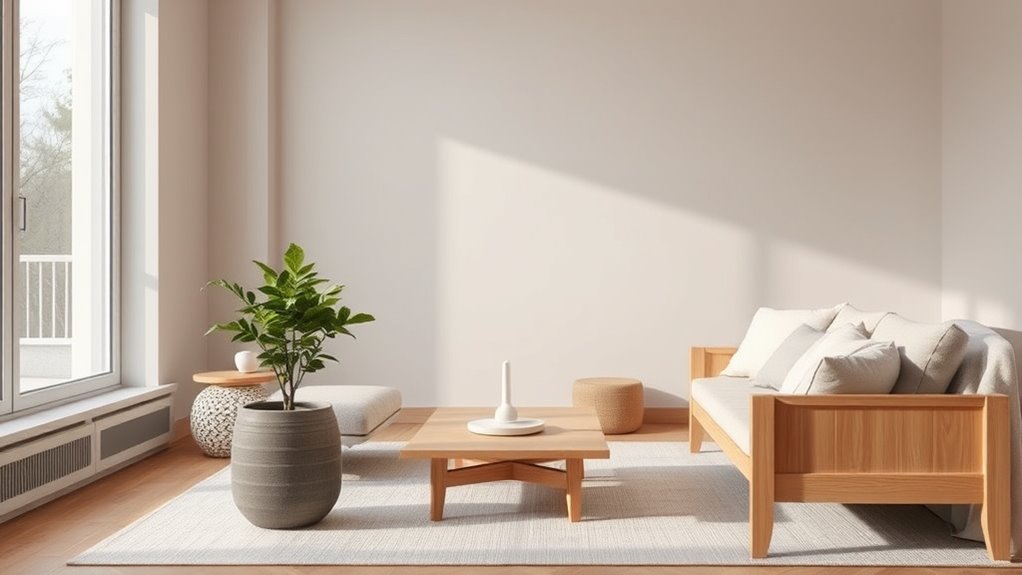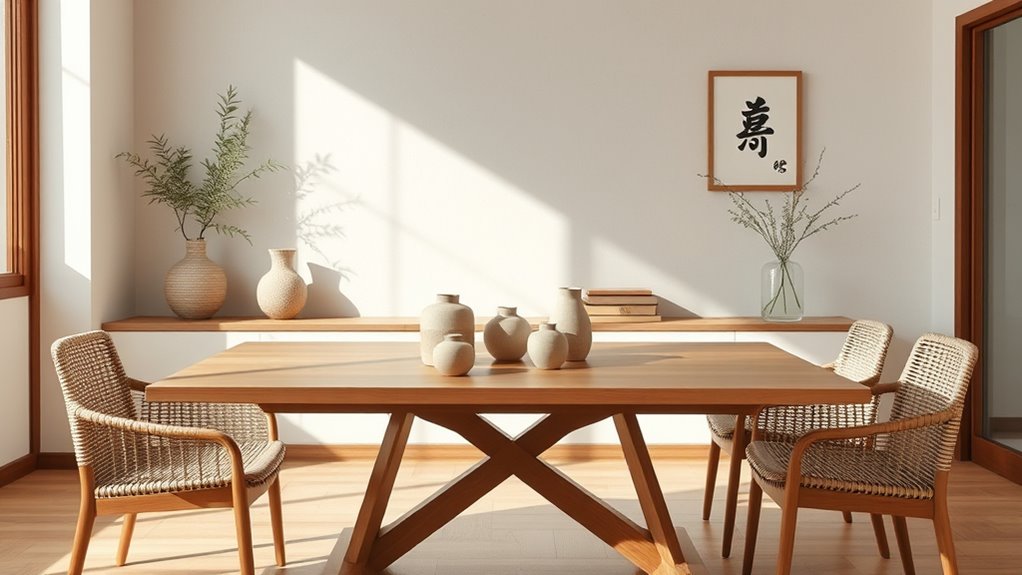Japandi style seamlessly blends Japanese minimalism’s calm and simplicity with Scandinavian warmth and coziness. You’ll find spaces that are uncluttered, featuring natural materials like light wood, stone, and linen, with a muted earthy color palette. This design promotes serenity, functionality, and understated elegance, creating a peaceful retreat that encourages mindfulness and relaxation. If you’re interested, there’s more to discover about how to incorporate these principles into your own space.
Key Takeaways
- Japandi style merges Japanese minimalism with Scandinavian warmth, emphasizing serenity, simplicity, and natural beauty.
- Uses natural materials like light wood, stone, and ceramics to create organic textures and a cozy atmosphere.
- Features neutral color palettes with earthy tones, open layouts, and uncluttered spaces for a calming environment.
- Focuses on minimal, carefully chosen decor that highlights craftsmanship and natural imperfections.
- Promotes a lifestyle of mindfulness, balance, and harmony with nature, creating a tranquil retreat at home.

Japandi style seamlessly blends the minimalism of Japanese design with the warm, functional aesthetic of Scandinavian decor. When you embrace this style, you’re inviting a space that’s both serene and inviting, rooted in simplicity yet rich in natural beauty. The core of Japandi is its minimalist aesthetics, which means every piece you choose should serve a purpose and contribute to a calm, clutter-free environment. You’ll find that clean lines, open spaces, and understated elegance are essential. Instead of overwhelming your room with excess decor, focus on a few well-chosen pieces that highlight the beauty of natural materials. This approach creates a harmonious balance, emphasizing quality over quantity and emphasizing the calming effect of simplicity.
Japandi blends Japanese minimalism with Scandinavian warmth, creating serene, functional spaces rooted in natural beauty and simplicity.
Natural materials play an integral role in achieving an authentic Japandi look. You’ll want to incorporate elements like light wood, stone, ceramics, and linen, all chosen for their organic textures and understated beauty. These materials not only add warmth but also deepen the connection to nature, which is central to Japandi’s philosophy. For instance, a low-profile wooden coffee table, paired with a linen sofa and ceramic vases, can instantly evoke the style’s tranquil vibe. The use of natural materials also ensures your space feels grounded and inviting, encouraging relaxation and mindfulness. You won’t find overly glossy or synthetic finishes here; instead, the focus remains on raw, textured surfaces that add depth and character without overwhelming the senses.
In your pursuit of a Japandi-inspired space, it’s essential to keep the color palette simple and earthy. Think soft beiges, warm greys, and muted browns, all working together to foster a sense of calm. These neutral tones serve as a perfect backdrop for the natural materials you select, allowing them to shine without distraction. Minimalist aesthetics extend beyond furniture and decor—your layout should promote an open flow, with plenty of negative space that enhances the peaceful atmosphere. You’ll appreciate how this clean, uncluttered environment helps clear your mind and creates a sanctuary that invites rest and reflection.
Ultimately, Japandi style is about more than just looks; it’s a lifestyle rooted in mindfulness, simplicity, and harmony with nature. By focusing on minimalist aesthetics and natural materials, you craft a space that’s both functional and beautiful. It’s a design approach that encourages you to slow down, appreciate the beauty of natural imperfections, and find balance in everyday life. When you get it right, your home becomes a peaceful retreat—a perfect blend of Japanese tranquility and Scandinavian coziness.
Frequently Asked Questions
How Does Japandi Style Influence Furniture Choices?
When choosing furniture, you’re influenced by a focus on minimalist decor and natural materials. You’ll opt for clean lines and simple designs that emphasize functionality, avoiding clutter. Natural wood finishes and earthy tones create a calming atmosphere. You prefer pieces that blend seamlessly into your space, promoting tranquility and balance. This style encourages you to select furniture that is both aesthetically pleasing and practical, fostering a serene environment inspired by both Japanese and Scandinavian aesthetics.
What Are Common Color Palettes in Japandi Interiors?
Think of a serene Zen garden, where calmness reigns. In Japandi interiors, you’ll find color combinations that mirror this tranquility, with neutral tones like beige, taupe, and soft grays creating a soothing backdrop. These palettes often incorporate muted blues and earthy greens for subtle contrast. The focus remains on simplicity and balance, making your space feel peaceful yet sophisticated, just like a quiet morning in a minimalist Scandinavian cabin.
Can Japandi Style Work in Small Spaces?
Yes, you can definitely make Japandi style work in small spaces. Focus on minimal storage solutions to avoid clutter and choose multifunctional furniture that maximizes every inch. Keep the color palette light and neutral to create an open, airy feel. This approach helps maintain the calm, minimalist aesthetic of Japandi while ensuring your small space feels functional and stylish.
Is Japandi Suitable for Outdoor Design?
You’re wondering if Japandi is suitable for outdoor design. The answer is yes, you can incorporate Japanese architecture principles into outdoor decor. Focus on simplicity, natural materials, and clean lines to create a serene space. Use wooden elements and minimalist furniture to reflect the Japandi style. This approach brings harmony and tranquility to your outdoor area, blending the calm elegance of Japanese architecture with Scandinavian functionality.
How Does Japandi Style Incorporate Sustainability?
Think of sustainability as the roots of a tree, grounding your style in eco-conscious choices. You incorporate sustainable materials like bamboo, reclaimed wood, and organic textiles, which are central to this design. By practicing eco-friendly methods, such as reducing waste and choosing low-impact finishes, you create a space that’s not only beautiful but also kind to the planet. This mindful approach makes your home a haven of harmony and environmental respect.
Conclusion
Think of Japandi style as a peaceful river, flowing smoothly between two tranquil landscapes—Japanese minimalism and Scandinavian coziness. It invites you to sail effortlessly through a space that balances simplicity and warmth. As you embrace this design, you’re like a gentle boat drifting on calm waters, finding harmony in every detail. Let Japandi be your guiding current, transforming your home into a serene sanctuary where style and comfort flow seamlessly together.









